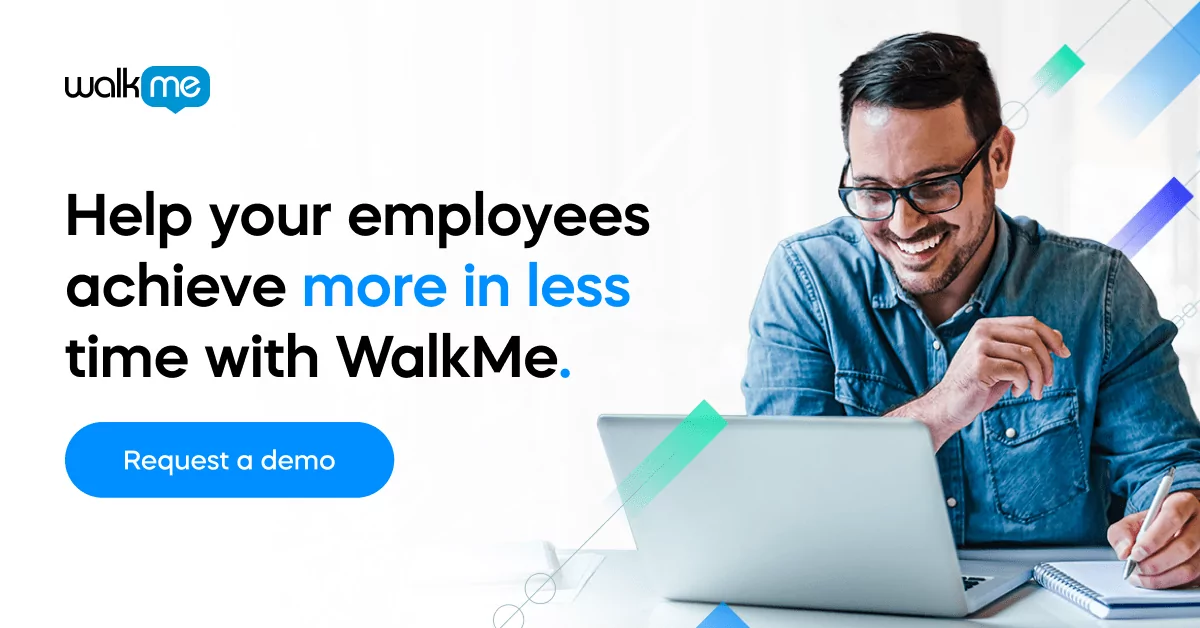Salesforce online training comes in several shapes and sizes, but what is the best choice for remote workforce training?
Since the productivity of sales teams depends on their ability to use sales software – and since their software skills depend on training – it is important to choose the right training methods.
Online training is usually the best choice since it is more affordable, convenient, and, of course, most suitable for today’s remote work environment.
Below, we’ll compare different types of Salesforce online training, then look at which factors to consider when deciding which route to take.
What’s the best option?
Here are some of the most popular online training options for the Salesforce platform:
Digital Adoption Platforms (DAPs)
Digital adoption platforms (DAPs) are systems that streamline and automate workflows for the user while simplifying the software learning process. They are UI layers that operate independently of their target platform, offering contextualized guidance as needed.
WalkMe’s DAP, for instance, includes features such as:
Analytics that track software usage and offer insight into users’ training needs
- Chatbots that help users find answers quickly and efficiently
- Walkthroughs that take users one step at a time through software workflows
These platforms are ideal for the digital workplace since they focus exclusively on practical job skills.
For example, WalkMe for Salesforce has modules specifically designed to teach Salesforce workflows and maximize user productivity. Furthermore, since they can be used either remotely or onsite, they are an excellent tool for Salesforce training.
On-demand video courses
Video courses are another common way employees learn to use Salesforce.
Udemy’s Salesforce courses, for instance, include topics such as:
- Salesforce Lightning
- Administrator certification preparation
- Salesforce development
- An introduction to basic concepts
Video courses such as these can be excellent for users who want more in-depth content that focuses on a specific area.
Webinars and online classes
A combination of webinars and online classes is another option for professionals who want in-depth training on a specific topic.
As with on-demand video courses, instructor-led training often focuses on a specific topic, such as:
- Salesforce administration
- Development
- Certification
Online classes are often geared towards professionals who want to attain a certain level of expertise in Salesforce. This can be useful in a few circumstances, but, as we will explain, it is not always the best choice for training entire sales teams.

Apps
Apps, such as the app included with Salesforce’s own Trailhead membership or the Udemy app, allow employees to study anywhere, anytime.
Convenience is perhaps the biggest benefit to learning from a mobile app. And while they can be used remotely, there are drawbacks.
Learning from a mobile phone, for instance, does not offer context nor does it offer immediacy.
Unless employees have Salesforce open in front of them, they will be more likely to forget what they have learned.
Certifications
Certifications are not a method of learning, but rather a blend of other types of training, such as video courses and instructor-led classes.
Certifications guarantee a certain level of competency upon course completion, so employees and employers both should consider investing in certification.
Since Salesforce is such a popular and sophisticated platform, there are several types of Salesforce certifications and credentials, such as:
- Salesforce administrator
- Salesforce architect
- Salesforce developer
- Salesforce marketer
- Salesforce consultant
Naturally, these types of certifications are most useful for employees who are serious about becoming Salesforce experts.
Not everyone is interested in becoming a Salesforce power user though, so employers must find another way to train and boost employee productivity on the platform.
Points to consider
Each type of training has its pros, cons, and specific use cases.
Some training methods, such as certification courses, are useful for building high-level expertise. Other types of training, such as digital adoption solutions, simplify onboarding and sales team training.
In many cases, it is best to create a comprehensive training program that includes more than one training method.
When building a program, it pays to consider:
The purpose of the training. If the aim is to improve the entire team’s productivity or shorten employee learning timelines, then it would be useful to consider tools that provide hands-on digital training. If there aren’t enough experienced users, however, it may be useful to consider hiring super-users or encouraging team members to become certified.
The employee experience. Different types of training deliver unique experiences, which can affect engagement and productivity. WalkMe’s DAP, for example, is designed to simplify the user experience as much as possible and reduce software-related frustration. The same goes for mobile apps, which minimize cognitive load through short tutorials and lessons.
Training quality and content. Certifications are only issued when candidates pass an exam that is developed by Salesforce, so courses that prepare students to pass these exams are usually trustworthy. However, unofficial apps, books, or courses may not have the same quality standards, so it is worth researching the content and the reputation of these types of sources beforehand.
In summary, managers and employees both should assess their needs carefully before investing time and money in Salesforce training. The right choice, after all, can offer significant returns, both in terms of productivity and profitability.


